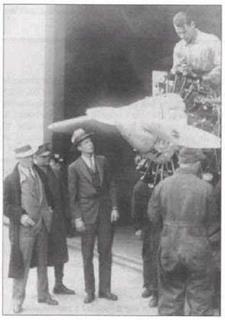By the Book
|
The Jenny wa* a Curtiss JN-4 biplane. In the 1920s when the Jenny was the favorite airplane of barnstormer*, airplanes had none of the radios or navigation equipment of modern airplanes. Pilot* were forced to navigate by deductive, or “dead* (pronounced dead) reckoning using predicted wind information combined with estimated flying speed and flying time. In theory, that basic information was sufficient to navigate by, but in practice, pilots carried road maps. |
|
Turbulence When Lindbergh was an air mail pilot, flying letters and parcels around the United States was the most dangerous job anyone could have. Out of the first 40 pilot* hired by the U.$. Post Office to fly the new air mail, 31 were killed in crashes. |
Eventually, Lindbergh decided to come down off the wing and learn to fly. Still, the “Lone Eagle,” as Lindbergh was later dubbed, began flying more like a “Lone Dodo,” and nearly crashed his first plane. He had been able to pay for only eight hours of training with an instructor on board, and he had not yet “soloed” by flying alone for the first time. After eight hours in the air, Lindbergh ran out of money and couldn’t afford any more lessons. What’s more, his flight instructor was starting to have second thoughts about whether flying was such a safe way to make a living!
But that didn’t ground Lindbergh. With the remaining few dollars from his air circus earnings, he bought one of thousands of World War I surplus planes, fondly known as Jennys. Still many hours short of earning his pilot’s license, Lindbergh slapped down $500 for a Jenny, and promptly prepared for his first solo flight, whether he was ready or not.
On his first attempt, Lindbergh’s airplane rolled across a field and struggled a few feet into the air. Lindbergh thought better of the takeoff and touched down again in what was partly a landing and partly a crash. But his plane wasn’t damaged, and Lindbergh swung it around for another attempt. That was when a kindhearted pilot who had watched the first takeoff offered Lindbergh a few tips, and with the words of that anonymous pilot ringing in his ears, Lindbergh took off into one of the most celebrated flying careers in history.
The “Flying Fool”
Lindbergh worked for a time as an air mail pilot, one of the most dangerous jobs anyone could have then. But for adventurous “Slim” Lindbergh, even the dangers of air mail flying weren’t enough to satisfy his restlessness. During mail flights, his thoughts began to wander to new challenges, including the $25,000 Orteig prize that restaurateur Raymond Orteig had put up as a bounty for the first person to fly between New York and Paris. When Orteig offered the cash in 1919,
he put a five-year deadline on the challenge. By 1924, no pilot had succeeded. Orteig gave pilots another five years to win the prize.
In 1926, Lindbergh paid Ryan Airlines Corporation to build him a plane capable of crossing the Atlantic. They created The Spirit of St. Louis, which was so stripped down that it was little more than a flying gas tank. Lindbergh decided that the safest place to position all that gas was close to the engine in front, so the tank was rigged directly in front of Lindbergh’s lightweight wicker seat, meaning he could only see forward by swerving the plane and looking out the side windows.
|
Lindbergh, center beneath propeller, inspects The Spirit of St. Louis, the plane that would carry him across the Atlantic in 33% hours and propel him to unprecedented fame. |
|
Plane Talk Lindbergh’s famous timidity and camera shyness came to him naturally. His parents were of stoic, Midwestern stock and reluctant to show their emotions. Lindbergh’s father once endured a stomach operation without anesthesia, and his mother, Evangeline, sent little Charlie off to sleep each night with a handshake. |














